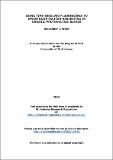Files in this item
Using time-resolved fluorescence to investigate exciton harvesting in organic photovoltaic blends
Item metadata
| dc.contributor.advisor | Samuel, Ifor D. W. | |
| dc.contributor.author | Ward, Alexander J. | |
| dc.coverage.spatial | xi, 272 p. | en_US |
| dc.date.accessioned | 2017-10-30T14:04:39Z | |
| dc.date.available | 2017-10-30T14:04:39Z | |
| dc.date.issued | 2014-09 | |
| dc.identifier.uri | https://hdl.handle.net/10023/11945 | |
| dc.description.abstract | This thesis is an investigation of the photophysical processes that occur in organic photovoltaic blends in the time between light being absorbed and free charges being generated. The purpose of all solar cells is to generate a photocurrent. The free charges, as they flow out of the device, make up the photocurrent, so understanding the processes by which they are created is vitally important to organic photovoltaic research. The main experimental method used was time-resolved fluorescence spectroscopy. This technique was used to probe the exciton population with respect to time for a variety of blends of organic semiconductors, including the high performance photovoltaic materials PCDTBT, PTB7, C71-PCBM and P3HT. The main goal of the work was to characterise the exciton diffusion lengths of these materials by developing a technique called volume quenching. Volume quenching involves blending a small quantity of quenching material into a thin film of semiconducting material. These introduced quenching sites render excitons unemissive on contact. Thus, from the drop in fluorescence compared with the ‘unquenched’ material, it was possible to work out what proportion of the initial excitons have encountered a quenching site in the blends. The results can then be fitted to quantify how diffusive the excitons are -i.e. how far they move. By looking at the rate constant of the quenching process and how it varies with respect to time, quencher concentration and quencher type, it was possible to generate a wealth of additional information, not just about exciton diffusion, but about all the inter-related processes that contribute to exciton harvesting. These processes included the measurement of long-range energy transfer from the donor to the acceptor, electron transfer at the interface with the acceptor and the understanding of nanomorphology of donor-acceptor heterojunctions. | en_US |
| dc.language.iso | en | en_US |
| dc.publisher | University of St Andrews | |
| dc.subject.lcc | TK8322.W2 | |
| dc.subject.lcsh | Time-resolved spectroscopy. | en |
| dc.subject.lcsh | Photovoltaic cells. | en |
| dc.subject.lcsh | Solar cells. | en |
| dc.title | Using time-resolved fluorescence to investigate exciton harvesting in organic photovoltaic blends | en_US |
| dc.type | Thesis | en_US |
| dc.type.qualificationlevel | Doctoral | en_US |
| dc.type.qualificationname | PhD Doctor of Philosophy | en_US |
| dc.publisher.institution | The University of St Andrews | en_US |
This item appears in the following Collection(s)
Items in the St Andrews Research Repository are protected by copyright, with all rights reserved, unless otherwise indicated.

